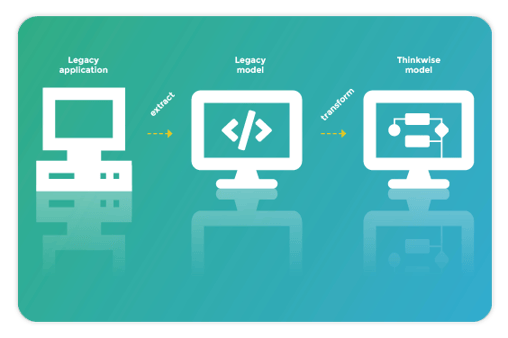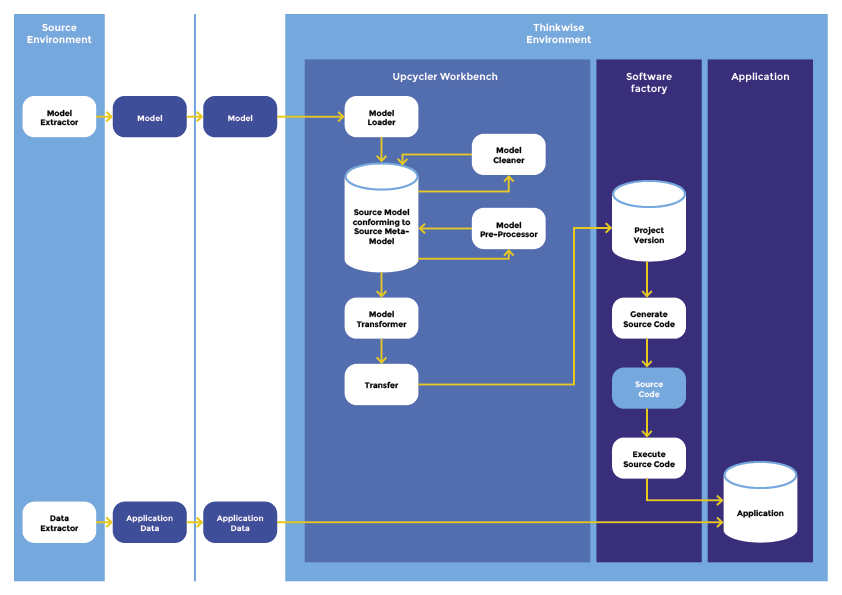New in the Thinkwise Platform: the integrated Thinkwise Upcycler
Version 2022.1 of the Thinkwise Platform will be released early this year. It is packed with new features, the most important addition being the integrated Thinkwise Upcycler.
The new Thinkwise Upcycler
We have been successfully upcycling legacy systems to the Thinkwise Platform for more than ten years. Up till now there was no easy way for Thinkwise customers or partners to perform Upcycles themselves. But that is about to change: the next release of our platform will include the Upcycler as a native application within the Thinkwise Platform.
The "Thinkwise Upcycler" was developed to allow for more frequent and faster use of the Upcyclers. Using the integrated Thinkwise Upcycler, customers and partners will be able to perform their own Upcycles by using predefined Upcyclers or customize an existing one.
Moving forward, it will even be possible to create your own Upcycler configurations for technologies that are not yet supported and share them via the new Thinkstore. The Thinkstore enables customers to share code and model examples with fellow developers.
How does the current Thinkwise Upcycler work?
In short, an upcycle transfers information from the legacy system to the Thinkwise development studio: the Software Factory. We transfer legacy systems to SQL Server databases and use this as the basis for the Upcycle.
The metadata from the current application is imported and analyzed. Using this metadata and automatic optimizations the platform creates the foundation for the new low-code model of the legacy solution, which can then be completely customized.

The difference between the present Upcycler and the new Thinkwise Upcycler
The basic information that is used in the current Upcycles often consists of table names, column names, types of columns, and relationships between tables. Using this information can already achieve very successful upcycles.
However, there is often far more information available. Examples include what the menus look like, screen translations, and in some cases code that can be transferred to the Software Factory. Up till now, this information was rarely ever used in the current upcycles.
To increase the potential and usability of upcycling legacy software, we have developed the Thinkwise Upcycler as an integrated component: an application within the Thinkwise Platform that is able to transfer and transform far more meta information than the previous method.
The upcycle process with the Thinkwise Upcycler
The process consists of the following steps:
1. Extract the modelDuring this step, we capture the meta information of the legacy system.
2. Extract the data
During this step, we capture the data from the legacy system.
3. Import the model
The file containing the meta-information is then imported into the Thinkwise Upcycler.
4. Upcycling
During the Upcycling the Thinkwise Upcycler transforms the meta-information from the legacy system to meta-information in accordance to the structure of the Thinkwise Software Factory. The Thinkwise Upcycler in the Software Factory then creates a Project and Version in which it stores the meta-information.
5. Deploy the application
This takes place in the usual manner in the Thinkwise Platform.
6. Import the data
The Thinkwise Upcycler inserts the data, contained in compressed files, into the deployed database.

The diagram above describes the architecture of the upcycling process.
Once all the steps are successfully completed, the upcycled application can be launched.
Which Upcyclers are available in the Thinkwise Upcycler?
The Thinkwise Upcycler will be delivered in release 2022.1 of the Platform. The Upcycler contains five different Upcyclers. More will be added following the launch.
Free the world of legacy software by 2030
Furthermore, this new and innovative feature will be a significant benefit to Thinkwise's mission:
'Free the world of legacy software by 2030'
Our ultimate goal is to free organizations worldwide from legacy software by the year 2030. We do this by using our platform to eliminate legacy software and offer a new alternative to traditional software and custom software. Applications built with Thinkwise are completely independent of technology. Thinkwise users from the very beginning have never had to rebuild their applications in the past 20 years.
The Thinkwise Upcycler helps us speed up this process even more. With the Upcycler you don't have to rethink everything and create a big jump start for your project.
Do you want to know more about the Upcycler?
Watch the webinar Case Study: Uniface Upcycler.